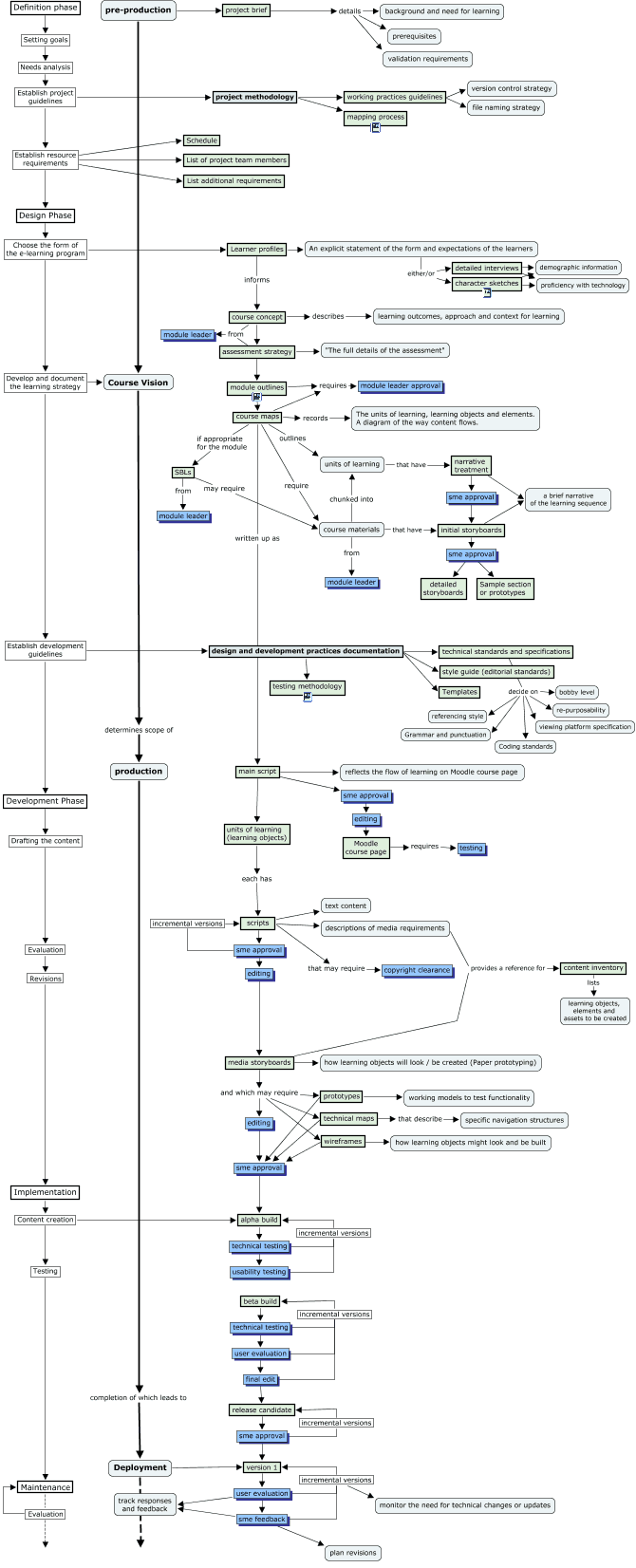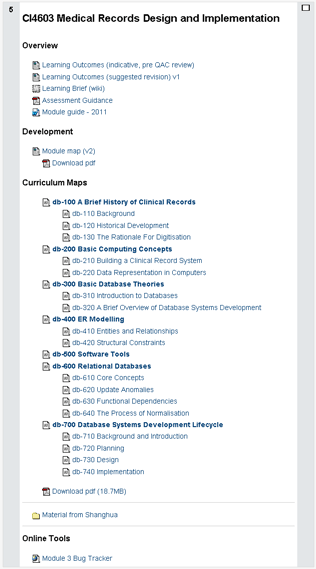Multimedia Design and Development
Only now, after having carefully considered the structure of each course module and having chunked its content into itemised learning units, do I contemplate the physical realisation of the course materials and begin the multimedia development phase.
Moving from top to bottom, the following workflow diagram illustrates how late in the development process content creation actually occurs.

Project Management
Before going into production, I draft four important documents;
- design guidelines,
- editorial standards,
- technical specifications and
- a user testing methodology.
On projects with medium to large scale teams, this documentation ensures that all stakeholders have a clear understanding of their roles and responsibilities. Clear guidelines promote consistency and ensure that the final materials are appropriate to the intended audience. They detail everything from coding standards and acceptable download times to the standardised use of punctuation and the module leader's choice of referencing style.
Importantly, these guidelines provide a quality assurance framework against which the finished courseware can be appraised before going live.
I make all of this documentation available online and use forums and a bug-tracking web application to promote communication between the members of the course team. Tasks can be assigned to one or more individuals, prioritised as necessary and audited for project management purposes.
![]()
The central repository for project files and discussions is the same VLE as will be used to deliver the course. From experience I have found that this allows lecturers to become accustomed to the system before their course or module begins.


Scripts, storyboards, prototypes and wireframes are all made available to lecturers as early as possible, allowing them to make comments, report bugs and suggest improvements to the developers. Rather than having subject matter experts 'dumping' materials on a learning technologist's desk I strongly encourage a close and continued collaboration between academic and technical staff. This is key to creating materials that are actually fit for purpose.
Multimedia Technologies
When deciding between the choice of tools, technologies and platforms for delivery - whether HTML, Flash, using the VLE's built-in activities or commercial solutions such as Adobe Captivate, a learning technologist's role is to support lecturers to do what they do best - teach - not to showcase their skills as a programmer. There's obviously room for innovation, and a multimedia developer should make recommendations on how a topic might best be presented, but it's crucial to find solutions that actually meet the needs of tutors and learners. Achieving this with the resources available and within the allocated time and budget is where a developer's creativity really shines through.
Rather than sticking with a one size fits all solution, I'm a strong believer that each lecturer's teaching style should inform the style and delivery of the materials. This allows them to feel ownership of their course materials and encourages them to engage with their students while the module is running.
Considerations of uniformity and consistency between modules are important but I also find that creating materials that use different styles and types of delivery keeps students interested and alert.
Most importantly, the topic itself dictates how the materials are best presented. The bottom line is to remain true to the instructional design strategies agreed to during the course mapping process. Form follows function. It may be that a complex software simulation has to be designed and built so that learners can safely explore the boundaries of their knowledge. At other times simply drafting a carefully worded question for a forum debate is all that's required.
I don't believe in technology for technology's sake. As a developer I like to spend my time building elements that actually enrich and benefit a course. Whenever possible why not pass on as much of the work onto your learners? A good example is to resist the temptation of providing direct links to journal articles. Instead, having properly referenced key texts and primary sources, students should be encouraged to find these publications for themselves either online or in a library. This promotes good academic practice and helps them develop research skills applicable to any course of study.

